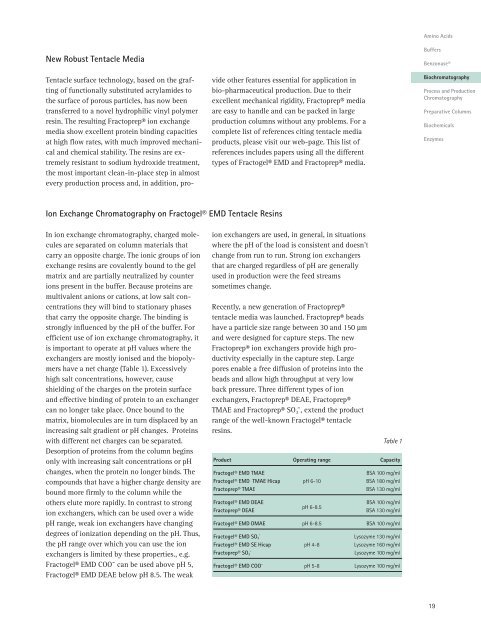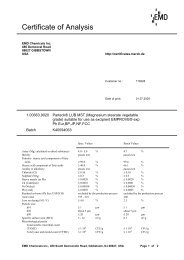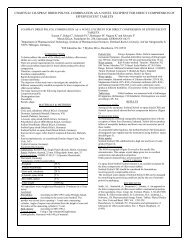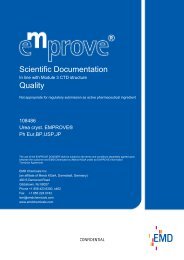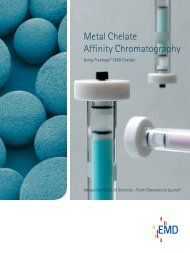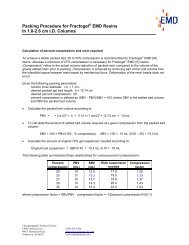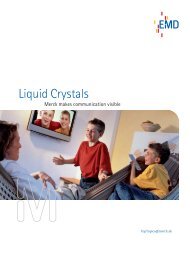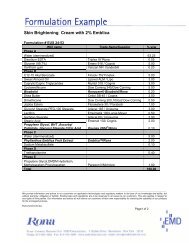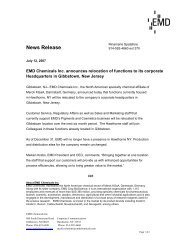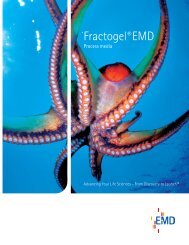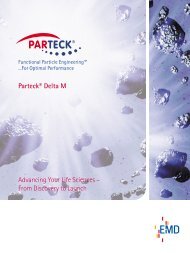Processing Catalog - EMD Chemicals
Processing Catalog - EMD Chemicals
Processing Catalog - EMD Chemicals
Create successful ePaper yourself
Turn your PDF publications into a flip-book with our unique Google optimized e-Paper software.
New Robust Tentacle Media<br />
Tentacle surface technology, based on the grafting<br />
of functionally substituted acrylamides to<br />
the surface of porous particles, has now been<br />
transferred to a novel hydrophilic vinyl polymer<br />
resin. The resulting Fractoprep® ion exchange<br />
media show excellent protein binding capacities<br />
at high flow rates, with much improved mechanical<br />
and chemical stability. The resins are extremely<br />
resistant to sodium hydroxide treatment,<br />
the most important clean-in-place step in almost<br />
every production process and, in addition, pro-<br />
Ion Exchange Chromatography on Fractogel® <strong>EMD</strong> Tentacle Resins<br />
In ion exchange chromatography, charged molecules<br />
are separated on column materials that<br />
carry an opposite charge. The ionic groups of ion<br />
exchange resins are covalently bound to the gel<br />
matrix and are partially neutralized by counter<br />
ions present in the buffer. Because proteins are<br />
multivalent anions or cations, at low salt concentrations<br />
they will bind to stationary phases<br />
that carry the opposite charge. The binding is<br />
strongly influenced by the pH of the buffer. For<br />
efficient use of ion exchange chromatography, it<br />
is important to operate at pH values where the<br />
exchangers are mostly ionised and the biopolymers<br />
have a net charge (Table 1). Excessively<br />
high salt concentrations, however, cause<br />
shielding of the charges on the protein surface<br />
and effective binding of protein to an exchanger<br />
can no longer take place. Once bound to the<br />
matrix, biomolecules are in turn displaced by an<br />
increasing salt gradient or pH changes. Proteins<br />
with different net charges can be separated.<br />
Desorption of proteins from the column begins<br />
only with increasing salt concentrations or pH<br />
changes, when the protein no longer binds. The<br />
compounds that have a higher charge density are<br />
bound more firmly to the column while the<br />
others elute more rapidly. In contrast to strong<br />
ion exchangers, which can be used over a wide<br />
pH range, weak ion exchangers have changing<br />
degrees of ionization depending on the pH. Thus,<br />
the pH range over which you can use the ion<br />
exchangers is limited by these properties., e.g.<br />
Fractogel® <strong>EMD</strong> COO - can be used above pH 5,<br />
Fractogel® <strong>EMD</strong> DEAE below pH 8.5. The weak<br />
vide other features essential for application in<br />
bio-pharmaceutical production. Due to their<br />
excellent mechanical rigidity, Fractoprep® media<br />
are easy to handle and can be packed in large<br />
production columns without any problems. For a<br />
complete list of references citing tentacle media<br />
products, please visit our web-page. This list of<br />
references includes papers using all the different<br />
types of Fractogel® <strong>EMD</strong> and Fractoprep® media.<br />
ion exchangers are used, in general, in situations<br />
where the pH of the load is consistent and doesn't<br />
change from run to run. Strong ion exchangers<br />
that are charged regardless of pH are generally<br />
used in production were the feed streams<br />
sometimes change.<br />
Recently, a new generation of Fractoprep®<br />
tentacle media was launched. Fractoprep® beads<br />
have a particle size range between 30 and 150 µm<br />
and were designed for capture steps. The new<br />
Fractoprep® ion exchangers provide high productivity<br />
especially in the capture step. Large<br />
pores enable a free diffusion of proteins into the<br />
beads and allow high throughput at very low<br />
back pressure. Three different types of ion<br />
exchangers, Fractoprep® DEAE, Fractoprep®<br />
TMAE and Fractoprep® SO 3 - , extend the product<br />
range of the well-known Fractogel® tentacle<br />
resins.<br />
Product Operating range Capacity<br />
Fractogel® <strong>EMD</strong> TMAE BSA 100 mg/ml<br />
Fractogel® <strong>EMD</strong> TMAE Hicap pH 6-10 BSA 180 mg/ml<br />
Fractoprep® TMAE BSA 130 mg/ml<br />
Fractogel® <strong>EMD</strong> DEAE BSA 100 mg/ml<br />
pH 6-8.5<br />
Fractoprep® DEAE<br />
BSA 130 mg/ml<br />
Fractogel® <strong>EMD</strong> DMAE pH 6-8.5 BSA 100 mg/ml<br />
–<br />
Fractogel® <strong>EMD</strong> SO3<br />
Lysozyme 130 mg/ml<br />
Fractogel® <strong>EMD</strong> SE Hicap pH 4-8 Lysozyme 160 mg/ml<br />
–<br />
Fractoprep® SO3<br />
Lysozyme 100 mg/ml<br />
Fractogel® <strong>EMD</strong> COO –<br />
Table 1<br />
pH 5-8 Lysozyme 100 mg/ml<br />
Amino Acids<br />
Buffers<br />
Benzonase®<br />
Biochromatography<br />
Process and Production<br />
Chromatography<br />
Preparative Columns<br />
Biochemicals<br />
Enzymes<br />
19


